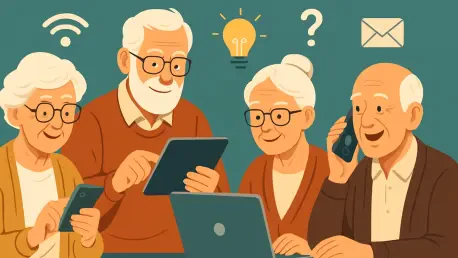In an era where social bonds are increasingly strained by distance and life changes, loneliness and depression among older adults have emerged as significant public health concerns, affecting millions globally and creating a pressing need for innovative solutions. Factors such as the loss of loved ones, reduced mobility, and evolving community dynamics often leave seniors disconnected from the support networks that once sustained them. This isolation can deeply impact mental well-being, leading to a diminished quality of life and heightened risks of health issues. As traditional avenues for connection become less accessible, the urgency to find innovative solutions grows. Digital technology presents a compelling opportunity to address these challenges, offering tools that can bridge gaps and foster meaningful interactions. From smartphones to specialized apps, these advancements hold the potential to transform the way older adults engage with the world, providing not just convenience but essential emotional lifelines that combat the pervasive effects of social isolation.
Harnessing Technology for Social Bonds
Bridging Distances with Video Communication
Video calling technology stands out as a powerful means to reconnect older adults with family and friends, no matter how far apart they may be. Platforms like Zoom and FaceTime enable real-time, face-to-face interactions that bring a personal touch to conversations, something traditional phone calls often lack. This visual connection can evoke a sense of presence, allowing seniors to share smiles, laughter, and even small daily moments with loved ones. Such interactions are crucial for alleviating feelings of loneliness, as they provide emotional nourishment that text or voice alone cannot fully deliver. The ability to see a familiar face can turn a solitary day into one filled with warmth, reinforcing relationships that might otherwise fade due to physical separation.
Moreover, the simplicity of many video calling tools today makes them increasingly viable for seniors, especially when supported by family or caregivers who can guide initial setup. These platforms often require just a few taps on a smartphone or tablet to initiate a call, reducing the intimidation factor for those less familiar with technology. Regular virtual meetups, whether for family gatherings or casual check-ins, can become a cherished routine, helping to maintain strong emotional ties. Beyond personal connections, some community organizations also use video calls to host group activities for seniors, further expanding their social reach. This technology, when embraced, serves as a vital tool to shrink the emotional distance created by physical barriers, offering a renewed sense of closeness.
Fostering New Ties Through Online Communities
Digital platforms designed for community engagement offer older adults a unique chance to build new relationships based on shared interests or life experiences. These virtual spaces allow seniors to join discussion groups, participate in hobby clubs, or simply connect with peers who understand their perspectives, creating a renewed sense of belonging. Unlike traditional social settings that may be hard to access due to mobility issues, these online communities are available at any time, providing flexibility and convenience. The emotional benefits are significant, as forming new friendships can counteract the isolation that often accompanies aging, replacing feelings of disconnection with a supportive network.
Additionally, many of these platforms are tailored specifically for older users, featuring intuitive designs and moderated environments to ensure safety and comfort. They often encourage interaction through events like virtual book clubs or shared storytelling sessions, which can spark meaningful conversations and camaraderie. For seniors who may have lost local social circles over time, these digital hubs offer a fresh start, helping them rediscover purpose through connection. The impact extends beyond individual well-being, as active engagement in such communities can also reduce the burden on family caregivers by providing alternative sources of social support. This approach highlights how technology can rebuild social fabrics in innovative, accessible ways.
Enhancing Mental Well-Being with Digital Resources
Expanding Access to Virtual Mental Health Care
Online therapy and counseling services represent a groundbreaking shift in how mental health support is delivered to older adults, breaking down barriers that often prevent seeking help. Many seniors hesitate to pursue in-person care due to stigma, transportation challenges, or discomfort with traditional settings, but digital platforms offer a discreet and convenient alternative. Through secure video sessions or chat-based support, these services allow individuals to connect with professionals from the privacy of their homes. This accessibility can lead to significant reductions in depression and anxiety, as timely intervention becomes more feasible for those who might otherwise go without care.
Furthermore, the variety of digital mental health tools available today caters to diverse needs, from structured therapy sessions to self-guided programs that teach coping strategies. These resources often include features like reminders and progress tracking, which can help seniors stay engaged in their mental health journey. For those in rural or underserved areas, where mental health providers may be scarce, virtual care fills a critical gap, ensuring that location is no longer a barrier to support. By lowering the threshold for entry, these platforms empower older adults to address emotional challenges proactively, fostering resilience and improving overall quality of life in a way that was previously out of reach for many.
Encouraging a Cultural Shift in Seeking Help
The integration of mental health resources into digital spaces also plays a pivotal role in normalizing help-seeking behavior among older adults. When therapy or counseling is accessible via familiar devices like smartphones or tablets, it becomes less daunting and more akin to everyday activities like video calls or browsing. This subtle shift can dismantle long-standing taboos around mental health, encouraging seniors to view professional support as a natural part of self-care rather than a sign of weakness. The anonymity and comfort of engaging from home further reduce hesitation, making it easier to take that first step toward addressing emotional struggles.
Beyond individual impact, this cultural change has broader implications for how society supports aging populations. As more seniors embrace digital mental health tools, communities can foster environments where open discussions about emotional well-being become commonplace, reducing isolation on a larger scale. Many platforms also offer educational content alongside therapy, equipping users with knowledge about mental health that can be shared with peers, amplifying awareness. This ripple effect not only benefits current users but also paves the way for future generations of older adults to approach mental health with confidence and openness, transforming societal attitudes over time.
Addressing Challenges in Digital Adoption
Building Skills for Tech Confidence
A significant obstacle to leveraging digital tools for combating loneliness is the varying level of tech proficiency among older adults, which can lead to frustration or avoidance of these solutions. Many seniors may feel overwhelmed by unfamiliar devices or applications, perceiving them as complex or irrelevant to their lives. Addressing this gap requires targeted educational initiatives that focus on hands-on learning, breaking down the use of smartphones, apps, and other tools into manageable steps. Community centers, libraries, and family members can play a key role in offering patient, empathetic guidance, ensuring that learning feels supportive rather than intimidating.
Equally important is the need to sustain this learning through ongoing support, as initial training alone may not suffice for long-term confidence. Regular workshops or helplines dedicated to tech assistance can help seniors troubleshoot issues and explore new features at their own pace. Tailoring content to their interests—such as connecting with grandchildren via video or joining hobby groups online—can make the learning process more engaging and relevant. Success stories from peers who have embraced technology can also inspire others to try, creating a positive feedback loop. By prioritizing digital literacy, the potential of these tools to reduce loneliness becomes accessible to a wider audience, ensuring no one is left behind due to skill barriers.
Securing Trust with Privacy Protections
Privacy concerns pose another substantial challenge in encouraging older adults to adopt digital tools, as fears about data security can deter usage even when benefits are clear. Seniors may worry about personal information being misused or shared without consent, especially given high-profile incidents of data breaches in recent years. To address this, technology providers must prioritize transparent policies that clearly explain how data is collected, stored, and protected. Robust encryption and user-friendly privacy settings can further reassure users that their information remains safe, building trust in these platforms.
In addition, education around digital safety is critical to empower seniors to navigate online spaces with confidence. Simple guides on recognizing phishing attempts, setting strong passwords, and understanding privacy agreements can mitigate risks and dispel fears. Collaboration between tech companies, policymakers, and advocacy groups is essential to establish industry standards that protect vulnerable users without compromising usability. When older adults feel secure, they are more likely to engage with digital solutions for social connection and mental health, unlocking the full potential of these tools. Trust, once established, becomes a cornerstone for widespread adoption, ensuring that privacy concerns do not overshadow the life-changing benefits of technology.
Reflecting on Progress and Future Steps
Looking back, the journey to integrate digital tools into the lives of older adults reveals both remarkable potential and persistent challenges in addressing loneliness and depression. Video calling platforms rekindled family ties across miles, while virtual communities offered new friendships to those who felt disconnected. Online therapy provided discreet access to mental health care, reshaping attitudes toward seeking help. Yet, hurdles like digital literacy and privacy fears underscore the need for tailored support and robust safeguards. These efforts, though complex, demonstrate how technology can transform isolation into connection when implemented thoughtfully.
Moving forward, the focus should shift to scaling these solutions through collaboration among tech developers, healthcare providers, and community organizations. Investment in user-friendly designs and comprehensive training programs will ensure broader accessibility for seniors. Policymakers must also advocate for stronger data protection laws to safeguard trust. By prioritizing inclusivity and empathy in digital innovation, society can create a future where no older adult feels left behind, harnessing technology to build stronger, more connected communities for all.









